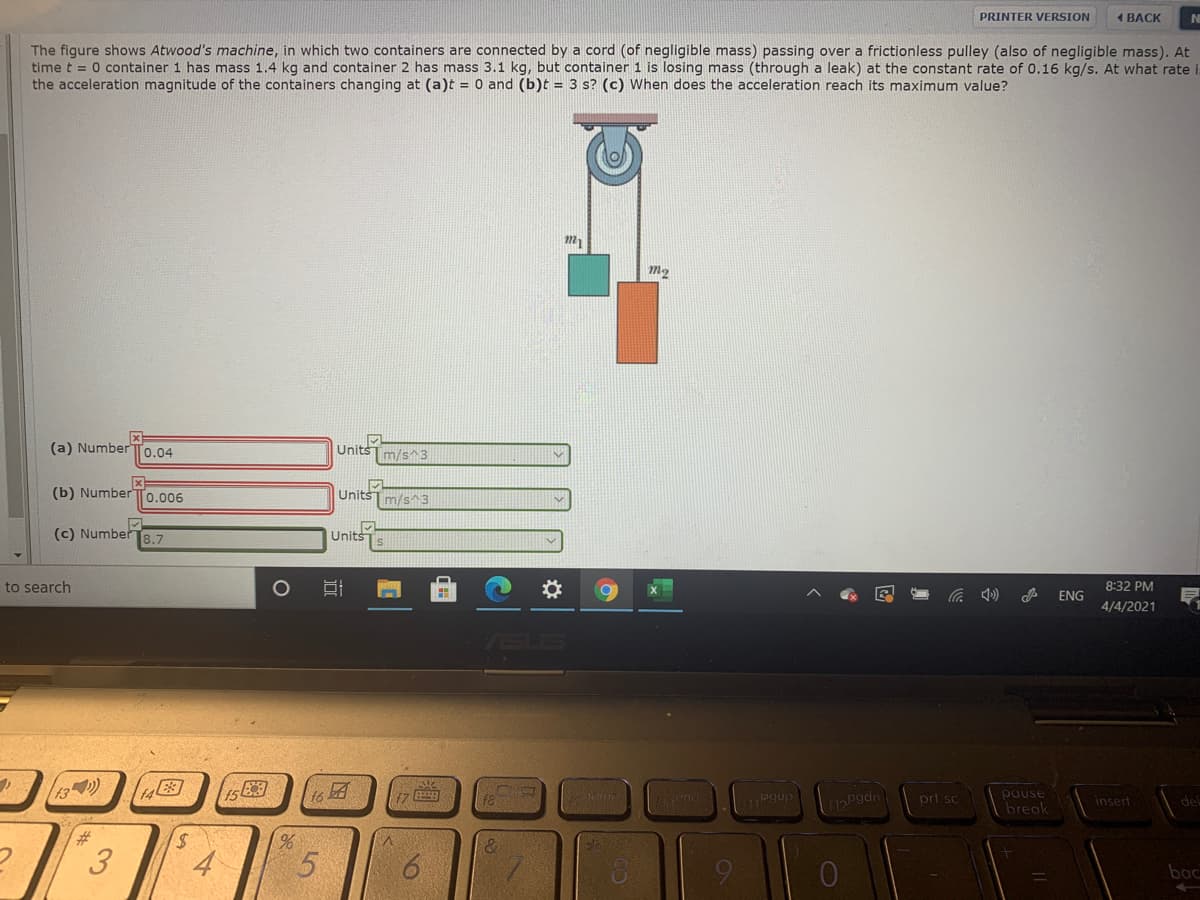The figure shows Atwood's machine, in which two containers are connected by a cord (of negligible mass) passing over a frictionless pulley (also of negligible mass). At time t = 0 container 1 has mass 1.4 kg and container 2 has mass 3.1 kg, but container 1 is losing mass (through a leak) at the constant rate of 0.16 kg/s. At what rate the acceleration magnitude of the containers changing at (a)t = 0 and (b)t = 3 s? (c) When does the acceleration reach its maximum value? (a) Number T0.04 Units m/s^3 (b) NumberTo.006 Units m/s^3 (c) Number 8.7 Units
The figure shows Atwood's machine, in which two containers are connected by a cord (of negligible mass) passing over a frictionless pulley (also of negligible mass). At time t = 0 container 1 has mass 1.4 kg and container 2 has mass 3.1 kg, but container 1 is losing mass (through a leak) at the constant rate of 0.16 kg/s. At what rate the acceleration magnitude of the containers changing at (a)t = 0 and (b)t = 3 s? (c) When does the acceleration reach its maximum value? (a) Number T0.04 Units m/s^3 (b) NumberTo.006 Units m/s^3 (c) Number 8.7 Units
University Physics Volume 1
18th Edition
ISBN:9781938168277
Author:William Moebs, Samuel J. Ling, Jeff Sanny
Publisher:William Moebs, Samuel J. Ling, Jeff Sanny
Chapter5: Newton's Law Of Motion
Section: Chapter Questions
Problem 57P: Two teams of nine members each engage in tug-of-war. Each of the first team’s members has an average...
Related questions
Question
100%

Transcribed Image Text:PRINTER VERSION
1 BACK
NI
The figure shows Atwood's machine, in which two containers are connected by a cord (of negligible mass) passing over a frictionless pulley (also of negligible mass). At
time t = 0 container 1 has mass 1.4 kg and container 2 has mass 3.1 kg, but container 1 is losing mass (through a leak) at the constant rate of 0.16 kg/s. At what rate
the acceleration magnitude of the containers changing at (a)t = 0 and (b)t = 3 s? (c) When does the acceleration reach its maximum value?
(a) NumberTo.04
UnitsTm/s^3
(b) Number
0.006
UnitsT m/s^ 3
(c) Number
8.7
Units
to search
8:32 PM
ENG
4/4/2021
ASUS
13
t6
Leno pgup
pause
bregk
prt sc
insert
del
%23
5.
9
bac
%24
3.
Expert Solution
This question has been solved!
Explore an expertly crafted, step-by-step solution for a thorough understanding of key concepts.
This is a popular solution!
Trending now
This is a popular solution!
Step by step
Solved in 2 steps with 2 images

Knowledge Booster
Learn more about
Need a deep-dive on the concept behind this application? Look no further. Learn more about this topic, physics and related others by exploring similar questions and additional content below.Recommended textbooks for you

University Physics Volume 1
Physics
ISBN:
9781938168277
Author:
William Moebs, Samuel J. Ling, Jeff Sanny
Publisher:
OpenStax - Rice University

Physics for Scientists and Engineers
Physics
ISBN:
9781337553278
Author:
Raymond A. Serway, John W. Jewett
Publisher:
Cengage Learning

Principles of Physics: A Calculus-Based Text
Physics
ISBN:
9781133104261
Author:
Raymond A. Serway, John W. Jewett
Publisher:
Cengage Learning

University Physics Volume 1
Physics
ISBN:
9781938168277
Author:
William Moebs, Samuel J. Ling, Jeff Sanny
Publisher:
OpenStax - Rice University

Physics for Scientists and Engineers
Physics
ISBN:
9781337553278
Author:
Raymond A. Serway, John W. Jewett
Publisher:
Cengage Learning

Principles of Physics: A Calculus-Based Text
Physics
ISBN:
9781133104261
Author:
Raymond A. Serway, John W. Jewett
Publisher:
Cengage Learning

Physics for Scientists and Engineers with Modern …
Physics
ISBN:
9781337553292
Author:
Raymond A. Serway, John W. Jewett
Publisher:
Cengage Learning

Physics for Scientists and Engineers, Technology …
Physics
ISBN:
9781305116399
Author:
Raymond A. Serway, John W. Jewett
Publisher:
Cengage Learning

College Physics
Physics
ISBN:
9781938168000
Author:
Paul Peter Urone, Roger Hinrichs
Publisher:
OpenStax College